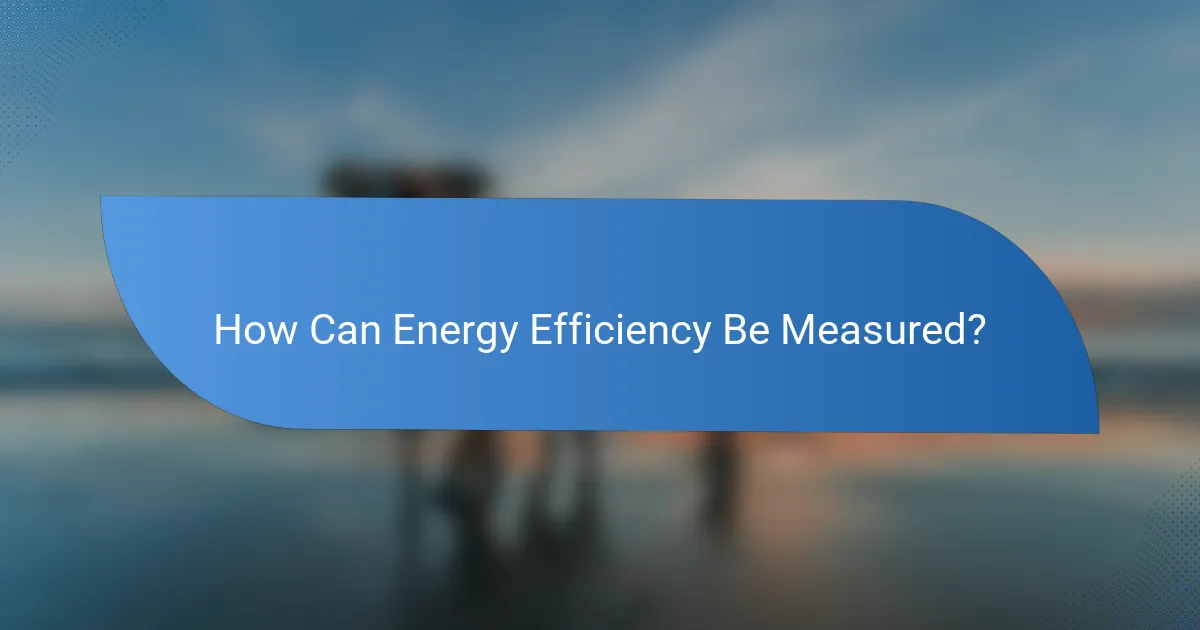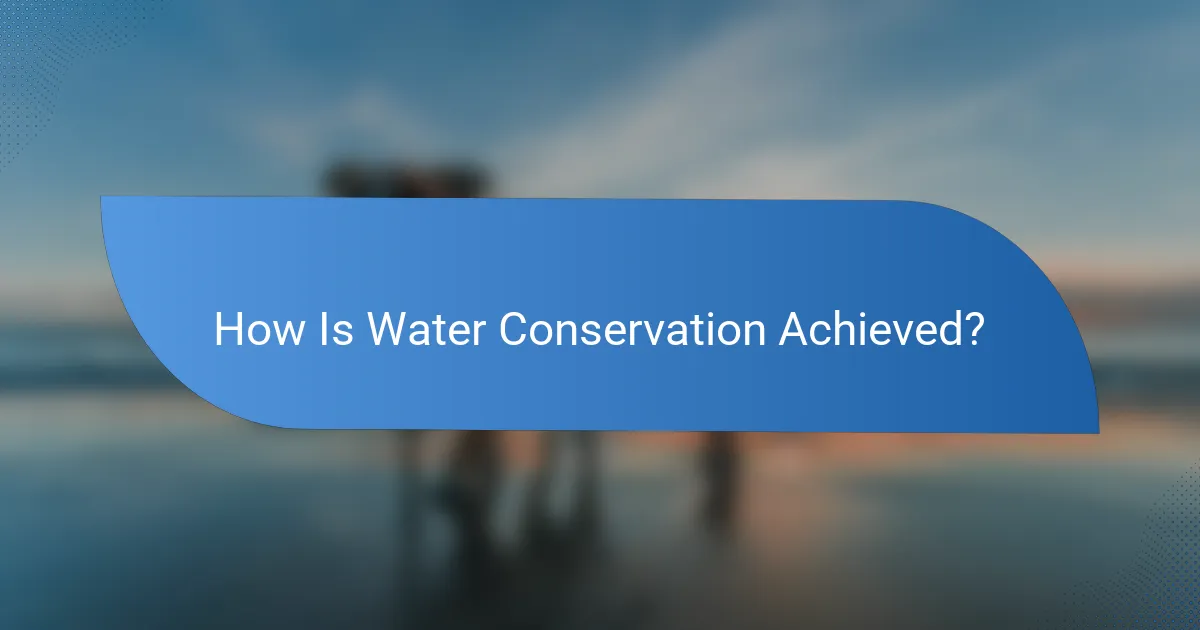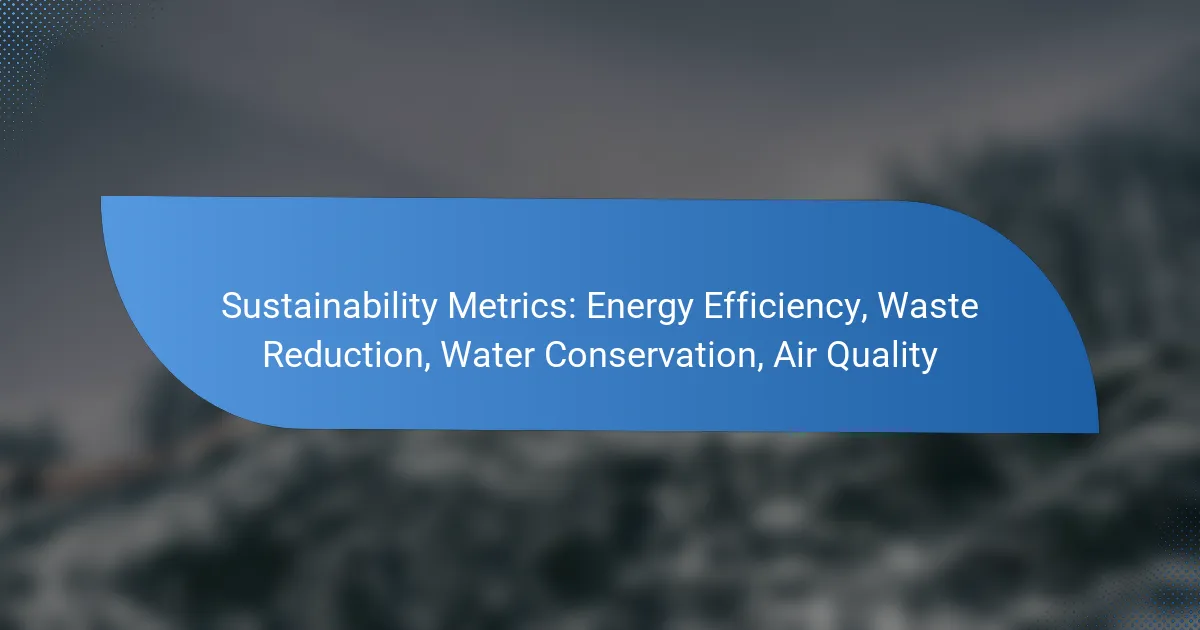Sustainability metrics play a crucial role in evaluating and enhancing environmental performance across various domains. By focusing on energy efficiency, waste reduction, water conservation, and air quality, organizations can implement effective strategies that not only benefit the planet but also promote economic savings. These metrics provide valuable insights that guide decision-making and foster a more sustainable future.

How Can Energy Efficiency Be Measured?
Energy efficiency can be measured using various metrics that assess how effectively energy is utilized in buildings and systems. Key methods include standardized ratings, certifications, and tools that provide insights into energy consumption and savings.
Energy Star Ratings
Energy Star ratings are a widely recognized metric for measuring energy efficiency in appliances and buildings. Products that meet strict energy performance standards set by the U.S. Environmental Protection Agency (EPA) receive this label, indicating they use less energy than similar models.
For buildings, the Energy Star Portfolio Manager allows property owners to track energy use and compare it to similar buildings, helping identify areas for improvement. A higher Energy Star score indicates better energy efficiency, with scores ranging from 1 to 100.
LEED Certification
LEED (Leadership in Energy and Environmental Design) certification is a globally recognized symbol of sustainability achievement. It assesses buildings based on various criteria, including energy efficiency, water conservation, and indoor air quality.
To achieve LEED certification, buildings must earn points across multiple categories, with higher levels such as Silver, Gold, and Platinum indicating greater sustainability. This certification not only enhances a building’s marketability but also often leads to lower operating costs.
kWh Savings
Measuring energy efficiency through kilowatt-hour (kWh) savings provides a clear picture of energy consumption reduction. This metric quantifies the amount of energy saved over a specific period, often expressed in annual savings.
For example, a commercial building that reduces its energy use by 10,000 kWh annually can significantly lower utility costs. Tracking kWh savings helps organizations set benchmarks and goals for future energy efficiency improvements.
Benchmarking Tools
Benchmarking tools are essential for comparing a building’s energy performance against similar properties or industry standards. These tools often utilize data analytics to identify trends and areas for improvement.
Common benchmarking tools include ENERGY STAR Portfolio Manager and the Building Performance Database. By regularly assessing energy use, organizations can implement targeted strategies to enhance efficiency and reduce costs.

What Are Effective Waste Reduction Strategies?
Effective waste reduction strategies focus on minimizing the amount of waste generated and maximizing resource efficiency. These approaches not only help the environment but can also lead to cost savings for businesses and households.
Zero Waste Initiatives
Zero waste initiatives aim to eliminate waste by redesigning resource life cycles so that all products are reused. This approach encourages practices such as reducing consumption, reusing materials, and recycling. Communities adopting zero waste strategies often set ambitious goals, such as diverting at least 90% of waste from landfills.
Key steps include conducting waste audits, engaging stakeholders, and implementing educational programs to promote sustainable practices. For example, cities like San Francisco have successfully implemented zero waste policies, achieving significant reductions in landfill waste.
Recycling Programs
Recycling programs are essential for diverting materials from landfills and conserving natural resources. These programs typically involve the collection, processing, and repurposing of materials like paper, plastics, and metals. Effective recycling initiatives can reduce waste by 20-30% in urban areas.
To enhance recycling efforts, communities should provide clear guidelines on what can be recycled, offer convenient collection services, and promote public awareness campaigns. For instance, many municipalities have adopted single-stream recycling, allowing residents to place all recyclables in one bin, simplifying the process.
Composting Systems
Composting systems transform organic waste, such as food scraps and yard debris, into nutrient-rich soil amendments. This process not only reduces the volume of waste sent to landfills but also enriches soil and supports local agriculture. Households can compost at home or participate in community composting programs.
To start composting, individuals should consider factors like bin size, materials to include (greens and browns), and maintenance practices. Many cities offer composting workshops and resources to help residents establish effective systems, which can divert up to 30% of household waste from landfills.

How Is Water Conservation Achieved?
Water conservation is achieved through various methods that reduce water usage and enhance efficiency. These techniques not only help in preserving this vital resource but also lower utility costs and support sustainable practices.
Rainwater Harvesting
Rainwater harvesting involves collecting and storing rainwater for later use, such as irrigation or household needs. This method can significantly reduce reliance on municipal water supplies, especially in areas with limited rainfall.
To implement rainwater harvesting, homeowners can install systems that include gutters, downspouts, and storage tanks. A well-designed system can capture thousands of liters of water annually, depending on the roof size and rainfall patterns.
Low-Flow Fixtures
Low-flow fixtures, such as faucets, showerheads, and toilets, are designed to use less water without sacrificing performance. These fixtures can reduce water consumption by 20-60%, making them a practical choice for both residential and commercial buildings.
When selecting low-flow fixtures, look for products labeled with the WaterSense label, which indicates they meet EPA standards for efficiency. Simple upgrades can lead to significant savings on water bills while contributing to overall conservation efforts.
Smart Irrigation Systems
Smart irrigation systems utilize technology to optimize watering schedules and amounts based on weather conditions, soil moisture, and plant needs. These systems can reduce water usage by up to 50% compared to traditional irrigation methods.
Consider installing a smart irrigation controller that adjusts watering times automatically. Additionally, incorporating moisture sensors can further enhance efficiency by ensuring that plants receive water only when necessary, preventing overwatering and runoff.

What Metrics Assess Air Quality?
Air quality is primarily assessed through various metrics that measure pollutants and their concentrations in the atmosphere. Key metrics include PM2.5 levels, VOC concentrations, and the Air Quality Index (AQI), each providing insights into the health of the air we breathe.
PM2.5 Levels
PM2.5 refers to particulate matter that is 2.5 micrometers or smaller in diameter, which can penetrate deep into the lungs and even enter the bloodstream. Monitoring PM2.5 levels is crucial as they can significantly impact respiratory health and overall well-being.
Regulatory agencies often set standards for PM2.5 concentrations, typically aiming for an annual mean of 12 micrograms per cubic meter (µg/m³) or lower. Regularly checking local air quality reports can help individuals stay informed about PM2.5 levels in their area.
VOC Concentrations
Volatile Organic Compounds (VOCs) are organic chemicals that can easily evaporate into the air and contribute to air pollution. Common sources include paints, solvents, and vehicle emissions. High concentrations of VOCs can lead to health issues, including headaches and respiratory problems.
To manage VOC levels, it is advisable to use low-VOC products and ensure proper ventilation in indoor spaces. Monitoring VOC concentrations can be done using portable air quality monitors, which provide real-time data on air quality.
Air Quality Index (AQI)
The Air Quality Index (AQI) is a standardized system used to communicate air quality levels to the public. It translates complex air quality data into a simple scale, typically ranging from 0 to 500, where lower values indicate better air quality and higher values signify worse conditions.
Understanding the AQI can help individuals make informed decisions about outdoor activities. For instance, an AQI below 50 is considered good, while values above 150 may indicate unhealthy conditions for sensitive groups. Regularly checking the AQI can guide outdoor plans, especially in urban areas where pollution levels can fluctuate.

What Frameworks Support Sustainability Metrics?
Several frameworks provide structured approaches to measuring sustainability metrics, including energy efficiency, waste reduction, water conservation, and air quality. These frameworks help organizations establish benchmarks, track progress, and improve their environmental performance.
ISO 14001 Standards
ISO 14001 is an international standard that outlines the criteria for an effective environmental management system (EMS). It helps organizations improve their environmental performance through more efficient use of resources and reduction of waste.
To implement ISO 14001, organizations should assess their current environmental impact, set measurable objectives, and continuously monitor their performance. Key steps include conducting an environmental review, developing an action plan, and engaging stakeholders in the process.
Common pitfalls include failing to involve employees or neglecting to update the EMS regularly. Organizations should ensure that all staff are trained and aware of their roles in achieving sustainability goals.
Global Reporting Initiative (GRI)
The Global Reporting Initiative (GRI) provides a comprehensive framework for sustainability reporting, helping organizations disclose their environmental, social, and governance (ESG) performance. This framework encourages transparency and accountability in sustainability practices.
Organizations using GRI should focus on identifying relevant sustainability topics, gathering data, and reporting on their performance against established indicators. The GRI Standards offer guidelines on how to report effectively, ensuring that disclosures are relevant and comparable.
To avoid common mistakes, organizations should prioritize stakeholder engagement and ensure the accuracy of reported data. Regularly updating reports and aligning them with stakeholder expectations can enhance credibility and trust in sustainability claims.

How Do Businesses Benefit from Sustainability Metrics?
Businesses benefit from sustainability metrics by improving operational efficiency, reducing costs, and enhancing their reputation. By tracking energy efficiency, waste reduction, water conservation, and air quality, companies can identify areas for improvement and make informed decisions that align with environmental goals.
Cost Savings
Implementing sustainability metrics can lead to significant cost savings for businesses. By monitoring energy usage, companies can identify inefficiencies and adopt energy-efficient technologies, potentially reducing energy bills by 10-30%. Similarly, waste reduction initiatives can lower disposal costs and even generate revenue through recycling programs.
For instance, a business that reduces its waste by 20% may save hundreds to thousands of dollars annually in waste management fees. Additionally, investing in water conservation measures can decrease water bills and minimize the costs associated with wastewater treatment.
To maximize cost savings, businesses should regularly review their sustainability metrics and set specific, measurable goals. Engaging employees in sustainability initiatives can also foster a culture of efficiency, leading to further reductions in operational costs.
